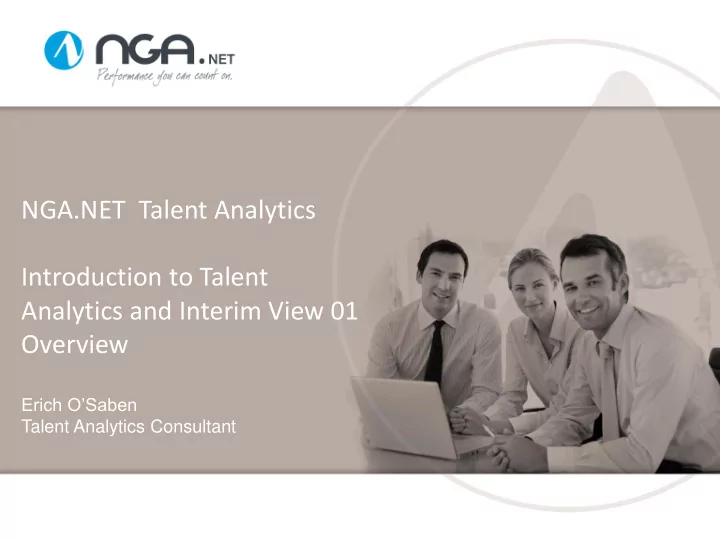

NGA.NET Talent Analytics Introduction to Talent Analytics and Interim View 01 Overview Erich O’Saben Talent Analytics Consultant
The Importance of Talent Analytics • Why are Analytics Important? • Support organizational decision-making • Ensure that the required information is provided to those who need it • Support Objectives and Strategies • It will enable you to use eRecruit as a key strategic tool • Analytics will help you: • Understand what’s working and what may not be • Work towards best practice and guide future system evolution
Our Philosophy to Analytics • Provision of powerful self-serve reporting • Presentation of data should be meaningful • Support the operational recruitment function • Support managerial and strategic decision-making • Full control over data visualization • Provide numerous ways of distributing information • Dashboard / Export / Report list • Build flexible reports that cater for a wide range of information requests
Powerful Data Visualization Column Combination Bar Financial Line Meter Map Area Pie Statistical Special Purpose
Features – Simplified Data Structure 1. Fields are in logical groupings based on three basic areas of eR : • Vacancies • Applications • Certificates 2. More pre-calculated fields such as: • Count of Certificates on a Vacancy • Count of Certificate Members on a Certificate • Count of Veterans Preference Eligible on a Certificate • Count of Hires or Selections on a Certificate
Features – Data Dictionary and User Interface 1. Simplified User Interface • Combined duplicative fields • Addition of pre-calculated fields • Fewer fields but more capability 2. Updated Naming Conventions • No two fields have the same name 3. Improved Folder Structure • Fields are grouped into categories by their context • From 20 folder categories to 8!
Features – Data Dictionary and User Interface (Cont) 4. Built in Data Dictionary 5. Date Hierarchies Timestamp – dd MMM yyyy hh:mm a Example: 08 May 2014 01:46 PM Date – dd MMM yyyy Example: 08 May 2014 Month – MMMM Example: January Year – YYYY Example: 2014
Features – Data Dictionary and User Interface (Cont) 6. Drill Down Analysis
Features – Data Dictionary and User Interface (Cont) 7. Enhanced Field Output Formatting 8. Removal of Test Vacancies from Reporting – Ticket #1799 • “Void”, “Test” & “Delete” in the Vacancy Announcement Number • Vacancies created by NGA.NET Staff
Interim View 01 Demo
Process for Adding GQs to Reporting • Making a GQ available in Reporting is a two step process: 1. Set the GQ Reporting Context • To be completed by the designated Sys Admin/SME 2. Submit a ticket to Team NTIS requesting that the field be added to the Reporting Module.
Next Steps • Available in all USDA Production Instances on Friday, June 28. • A user guide will be provided which includes the following topics: • Building an Ad Hoc Report • Building an Ad Hoc Report using Filters • Using Charts and Graphs in Reports • Formatting an Ad Hoc Report • Creating and Editing a Dashboard
Recommend
More recommend